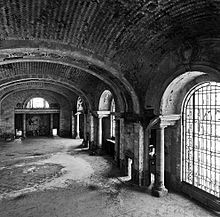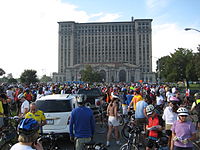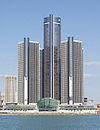- Michigan Central Station
-
Michigan Central Station
 Michigan Central Station in 2010
Michigan Central Station in 2010Location: 2405 West Vernor Highway
Detroit, MichiganCoordinates: 42°19′43.69″N 83°4′39.83″W / 42.3288028°N 83.0777306°WCoordinates: 42°19′43.69″N 83°4′39.83″W / 42.3288028°N 83.0777306°W Area: 500,000 sq ft (46,000 m2) Architect: Reed and Stem,
Warren and WetmoreArchitectural style: Beaux-Arts Governing body: Private NRHP Reference#: 75000969 Added to NRHP: April 16, 1975 Michigan Central Station (also known as Michigan Central Depot or MCS), built in mid-1912 through 1913 for the Michigan Central Railroad, was Detroit, Michigan's passenger rail depot from its opening in 1913 after the previous Michigan Central Station burned, until the cessation of Amtrak service on January 6, 1988. At the time of its construction, it was the tallest rail station in the world.[1]
The building is located in the Corktown district of Detroit near the Ambassador Bridge approximately 3⁄4-mile (1.2 km) southwest of downtown Detroit. It is located behind Roosevelt Park, and the Roosevelt Warehouse is adjacent to the east. The city's Roosevelt Park serves as a grand entry way to the station. It was added to the National Register of Historic Places in 1975. Restoration projects and plans have gone as far as the negotiation process, but none have come to fruition. In 2011, the building owner added new windows. Full restoration of Michigan Central Station would be a large-scale project requiring significant investment.
Contents
History
The building began operating as Detroit's main passenger depot in 1913 after the older Michigan Central Station burned on December 26, 1913. It was planned as part of a large project that included the Michigan Central Railway Tunnel below the Detroit River for freight and passengers. The old station was located on a spur line which was inconvenient for the volume of passengers it served. The new Michigan Central would place passenger service on the main line.
 Michigan Central Station's Beaux-Arts facade
Michigan Central Station's Beaux-Arts facade
The growing trend toward increased automobile use was not a large concern in 1912, as is evident in the design of the building. Most passengers would arrive at and leave from Michigan Central Station by interurban service or streetcar and not as pedestrians due to the station's distance from downtown Detroit. The station was placed away from downtown in the hope that the station would be an anchor for development to follow.
At the beginning of World War I, the peak of rail travel in the United States, more than two hundred trains left the station each day and lines would stretch from the boarding gates to the main entrance. In the 1940s, more than four thousand passengers a day used the station and more than three thousand people worked in its office tower. Among those who arrived at MCS were Presidents Herbert Hoover, Harry S. Truman and Franklin D. Roosevelt, actor Charlie Chaplin and inventor Thomas Edison.
Things were looking up as Henry Ford began to buy land near the station in the 1920s and made construction plans, but the Great Depression and other circumstances squelched this and many other development efforts. Further compounding MCS's future problems was the fact that the original design included no large parking facility. So, when the interurban service was discontinued less than two decades after MCS opened, MCS was effectively isolated from a large majority of the population.
However, even with fewer means to get to and from the station, passenger volume did not decrease immediately. During World War II, the station saw heavy military use, but once the war ended, passenger volume began to decline. Service was cut back and passenger traffic became so low that the owners of the station attempted to sell the facility in 1956 for US$5 million, one-third of its original building cost in 1913. Another attempt to sell the building occurred in 1963, but again there were no buyers. In 1967, maintenance costs were seen as too high relative to the decreasing passenger volume. The restaurant, arcade shops, and main entrance were closed, along with much of the main waiting room. This left only two ticket windows to serve passengers and visitors, who used the same parking-lot entrance as railroad employees working in the building.
Things began to look better for the building when Amtrak took over the nation's passenger rail service in 1971. The main waiting room and entrance were reopened in 1975 and a $1.25 million renovation project began in 1978. But only six years later, the building was sold for a transportation center project that never materialized and on January 6, 1988, the last Amtrak train pulled away from the station after it was decided to close the facility. Amtrak service continued at a platform near the building until a new station opened several miles away in New Center in 1994.[2]
In July 1992, the Detroit Master Plan of Policies for the southwest sector's urban design identified the station as an attractive or interesting feature to be recognized, enhanced and promoted.[3]
Controlled Terminals Inc. acquired the station in 1996. Its sister company, the Detroit International Bridge Co., owns the nearby Ambassador Bridge and both are part of a group of transportation-related companies owned by businessman Manuel Moroun, Chairman and CEO of CenTra Inc.[4][5]
The station has appeared in several films.[6] MCS was used for scenes in the movie Transformers (directed by Michael Bay) in October 2006. In January 2005, it was used as a location set for the movie The Island (also directed by Michael Bay). In September 2002, extensive closeups and fly-by shots were featured in the movie Naqoyqatsi. The 2004 film Four Brothers opens with the main character driving his car along the front of Michigan Central Station towards Michigan Ave. The building has been used in some of Eminem's work, including the title sequence of the movie 8 Mile and his music video for the song "Beautiful", during the beginning of which the building features prominently. A scene from the ABC crime drama Detroit 1-8-7 was shot and set inside the station.
The City of Detroit considered the building a "Priority Cultural Site" in 2006,[7] the City Council on April 7, 2009 passed a resolution aimed at the demolition of the Depot.[8] Seven days later, Detroit resident Stanley Christmas sued the city of Detroit to stop the demolition effort, citing the National Historic Preservation Act of 1966.[9] The future of the building remains undetermined.
Architecture
The building is of the Beaux-Arts Classical style of architecture, designed by the Warren & Wetmore and Reed and Stem firms who also designed New York City's Grand Central Terminal. The price tag for this 500,000-square-foot (46,000 m2) building was $15 million when it was built. Roosevelt Park creates a grand entryway for the station, which was fully realized around 1920.
The building is composed of two distinct parts: the train station itself and the 18-story tower. The roof height is 230 feet (70 m). Ideas as to what the tower was originally designed to include a hotel, offices for the rail company, or a combination of both. In reality, the tower was only used for office space by the Michigan Central Railroad and subsequent owners of the building. The tower was never completely utilized; the top floors were never completely furnished, and served no function.
The main waiting room on the main floor was modeled after an ancient Roman bathhouse with walls of marble and vaulted ceilings. The building also housed a large hall adorned with Doric columns that housed the ticket office and an arcade shops. Beyond the arcade was the concourse, which had brick walls and a large copper skylight. From here, passengers would walk down a ramp to the departing train platforms, 11 tracks in all. Below the tracks and building is a large area for baggage and mail handling and offices.
Future development
Cyclists gather in Detroit's Roosevelt Park for the Tour de Troit
In 2008, the station owners said that their goal is to renovate the decaying building that was closed in 1988. The estimated cost of renovations was $80 million, but the owners viewed finding the right use as a greater problem than financing.[6] On March 25, 2011, in an effort to push forward a potential sale and redevelopment of the depot, Dan Stamper, spokesperson for Ambassador Bridge owner Manuel Moroun, announced plans to work with the City of Detroit on funding replacement of the tower's roof, and installing new windows on the structure. Stamper told the Detroit News: "... It would be much easier to help a developer to come up with a package to use the depot if some improvements were made."[10]
Proposals and concepts for redevelopment in the past have included these potential uses:
- Trade Processing Center - One proposal suggested turning the station into a customs and international trade processing center due to its proximity to the Ambassador Bridge.[11]
- Convention Center and Casino - Ambassador Bridge owner Manuel J. "Matty" Moroun,[4] proposed that Michigan Central Station be restored as the centerpiece of a new convention center, possibly combined with a casino. Such a project could cost $1.2 billion, including $300 million to restore the station. Dan Stamper, president of Detroit International Bridge, noted that the station should have been used as one of the city's casinos.[6]
- Detroit Police Headquarters - In 2004 Detroit mayor Kwame Kilpatrick announced that the city was pursuing options to relocate its police department headquarters and possibly consolidate other law enforcement offices to MCS. However, in mid-2005, the city cancelled the plan and chose to renovate its existing police headquarters.[11]
- Michigan State Police Headquarters - In 2010, State Senator Cameron S. Brown and Mickey Bashfield, a government relations official for the building owner CenTra Inc., suggested that the station could become the Detroit headquarters of the Michigan State Police, include some United States Department of Homeland Security offices, and serve as a center for trade inspections.[12]
Renovation estimates have ranged from $80 to $300 million. The Detroit Wayne County Port Authority has the ability to issue bonds and could take part in financing.
The U.S. Department of Transportation has awarded $244 million in grants for high-speed rail upgrades between Chicago and Detroit.[13] A consortium of investors including the Canadian Pacific Railway has proposed a new larger rail tunnel capable of handling large double stacked freight cars under the Detroit River which could open in 2015.[14] With the new tunnel emerging near the Michigan Central Station, a redeveloped station could play a role as a trade inspection facility.[12]
On May 5, 2011, the Detroit International Bridge Company announced it engaged the Ann Arbor firm of Quinn Evans to oversee restoration of the roof and windows of the structure. Bridge Company vice chairman Matthew Moroun stated, “We hope this is just the beginning of a renaissance for the depot."[15]
On June 6, 2011, partial Asbestos abatement on the first floor will begin. The work will be conducted by Professional Abatement Services, Inc. of Melvindale, Michigan.[16]
See also
Notes
- ^ Kavanaugh, Kelli B. (2001). Detroit's Michigan Central Station (Images of America). Arcadia Publishing. ISBN 0-7385-1881-6.
- ^ Amtrak (May 1, 1994). "National Timetable Spring/Summer 1994". http://www.timetables.org/full.php?group=19940501n&item=0021. Retrieved 2011-11-05.
- ^ "Southwest Sector Policies, Article 309, POLICY 309-7". City of Detroit. July 1002. http://www.detroitmi.gov/Portals/0/docs/planning/planning/MPlan/current_mplan/text/Article%20309%20-%20Southwest%20Sector.pdf. Retrieved 2011-05-05.
- ^ a b Stephanie Fitch and Joann Muller (15 November 2004). "The Troll Under the Bridge". Forbes (Forbes.com). http://www.forbes.com/forbes/2004/1115/134.html. Retrieved 2011-05-05.
- ^ S Voyles (May–June 2009). "The Man Behind the Bridge - Matty Moroun Talks about Detroit, Business and Being Sentimental". Corp! (CorpMagazine.com). http://www.corpmagazine.com/Departments/CoverStories/tabid/54/itemid/701/Default.aspx. Retrieved 2011-05-05.
- ^ a b c Louis Aguilar (8 April 2008). "Michigan Central Depot owners say 'Roll 'em!". The Detroit News (Detnews.com). http://www.detnews.com/apps/pbcs.dll/article?AID=/20080408/BIZ/804080348. Retrieved 2008-07-29.
- ^ "Non-motorized Urban Transportation Master Plan". City of Detroit. June 2006. p. 20. http://www.detroitmi.gov/Portals/0/docs/planning/planning/nonmotor/Nonmotorized_Urban_Transportation_Master_Plan.pdf. Retrieved 2011-05-05.
- ^ WDIV-Detroit (7 April 2009). "City Council Votes To Demolish Depot". ClickonDetroit.com. http://www.clickondetroit.com/news/19120317/detail.html. Retrieved 2011-05-05.
- ^ WDIV-Detroit (8 April 2009). "Lawsuit Filed In Train Depot's Future". ClickonDetroit.com. http://www.clickondetroit.com/news/19130672/detail.html. Retrieved 2011-05-05.
- ^ Tom Greenwood (25 March 2011). "Decaying Central Depot to get spruce-up". The Detroit News (DetNews.com). http://detnews.com/article/20110325/METRO01/103250394/1410/METRO01/Decaying-Central-Depot-to-get-spruce-up. Retrieved 2011-05-05.
- ^ a b Ann Mullen (6 August 2006). "On Track". Metro Times (MetroTimes.com). http://www.metrotimes.com/editorial/story.asp?id=5221. Retrieved 2008-07-29.
- ^ a b "New York Times asks: What's to be done with Michigan Central Station?". Model D. 9 March 2010. http://www.modeldmedia.com/inthenews/mcs030910.aspx.
- ^ Nathan Bomey (28 January 2010). "High-speed rail grants include $244 million for Detroit-to-Chicago Amtrak improvements". Ann Arbor News (annarbor.com). http://www.annarbor.com/business-review/high-speed-rail-grants-include-244-million-for-detroit-to-chicago-amtrak-improvements. Retrieved 2011-05-05.
- ^ Bill Shea (17 June 2010). "Windsor Port Authority joins group seeking to build $400 million rail tunnel". Crain's Detroit Business (CrainsDetroit.com). http://www.crainsdetroit.com/article/20100617/FREE/100619884. Retrieved 2010-07-07.
- ^ John Gallagher (5 May 2011). "Bridge Company moves ahead with Michigan Central Depot restoration". Detroit Free Press (freep.com). http://www.freep.com/article/20110505/BUSINESS06/110505028/Bridge-Company-moves-ahead-Michigan-Central-Depot-restoration?odyssey=tab. Retrieved 2011-05-05.
- ^ "Asbestos Project Notification". Michigan Department of Licensing and Regulatory Affairs. http://www.dleg.state.mi.us/asbestos_program/rs_prono.asp?cname=&fname=MICHIGAN+CENTRAL+STATION+%28FORMER%29&address=&city=Detroit&cnty_name=%25&startdate=06%2F03%2F2011&months=5&years=2011&enddate=12%2F31%2F2011&months=11&years=2011. Retrieved 2011-06-03.
References and further reading
- Hill, Eric J. and John Gallagher (2002). AIA Detroit: The American Institute of Architects Guide to Detroit Architecture. Wayne State University Press. ISBN 0-8143-3120-3.
- Kavanaugh, Kelli B. (2001). Detroit's Michigan Central Station (Images of America). Arcadia Publishing. ISBN 0-7385-1881-6.
- Meyer, Katherine Mattingly and Martin C.P. McElroy with Introduction by W. Hawkins Ferry, Hon A.I.A. (1980). Detroit Architecture A.I.A. Guide Revised Edition. Wayne State University Press. ISBN 0-8143-1651-4.
- Sharoff, Robert (2005). American City: Detroit Architecture. Wayne State University Press. ISBN 0-8143-3270-6.
- Sobocinski, Melanie Grunow (2005). Detroit and Rome: building on the past. Regents of the University of Michigan. ISBN 0933691092.
External links
- Michigan Central Station at Emporis
- Michigan Central Station at SkyScraperPage
- Save Michigan Central Latest conservation effort and the official home of the Michigan Central Station Preservation Society.
- Michigan Central Station at Buildings of Detroit
- Michigan Central Station at Detroiturbex.com
- Gigapan of Michigan Central Station High resolution image of the station in 2009
City of Detroit Architecture · Culture · Detroit River · Economy · Freeways · Government · History · Historic places · International Riverfront · Media · Music · Neighborhoods · Parks and beaches · People · Skyscrapers · Sports · Theatre · Tourism · Transportation

Metro Detroit · Michigan · United States U.S. National Register of Historic Places Topics Lists by states Alabama • Alaska • Arizona • Arkansas • California • Colorado • Connecticut • Delaware • Florida • Georgia • Hawaii • Idaho • Illinois • Indiana • Iowa • Kansas • Kentucky • Louisiana • Maine • Maryland • Massachusetts • Michigan • Minnesota • Mississippi • Missouri • Montana • Nebraska • Nevada • New Hampshire • New Jersey • New Mexico • New York • North Carolina • North Dakota • Ohio • Oklahoma • Oregon • Pennsylvania • Rhode Island • South Carolina • South Dakota • Tennessee • Texas • Utah • Vermont • Virginia • Washington • West Virginia • Wisconsin • WyomingLists by territories Lists by associated states Other  Category:National Register of Historic Places •
Category:National Register of Historic Places •  Portal:National Register of Historic PlacesCategories:
Portal:National Register of Historic PlacesCategories:- Landmarks in Michigan
- Skyscrapers in Detroit, Michigan
- Stations along Michigan Central Railroad lines
- History of Detroit, Michigan
- Railway stations opened in 1913
- Railway stations closed in 1988
- Union stations in the United States
- 1913 architecture
- Beaux-Arts architecture in Michigan
- Railway stations on the National Register of Historic Places in Michigan
- Construction projects in the United States
- Former Amtrak stations in Michigan
- Unused buildings in Michigan
- Reed and Stem buildings
- Warren and Wetmore buildings
Wikimedia Foundation. 2010.




